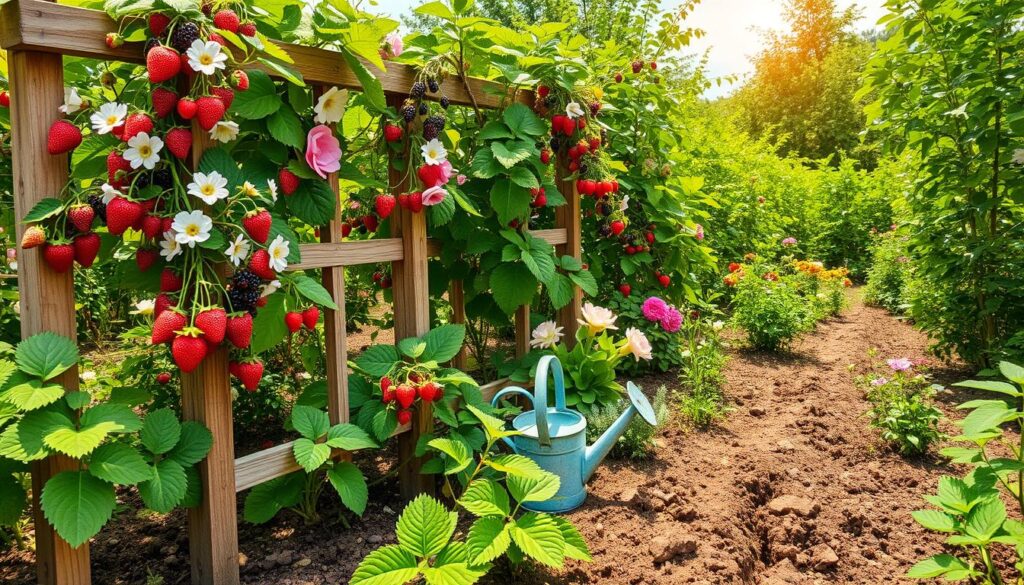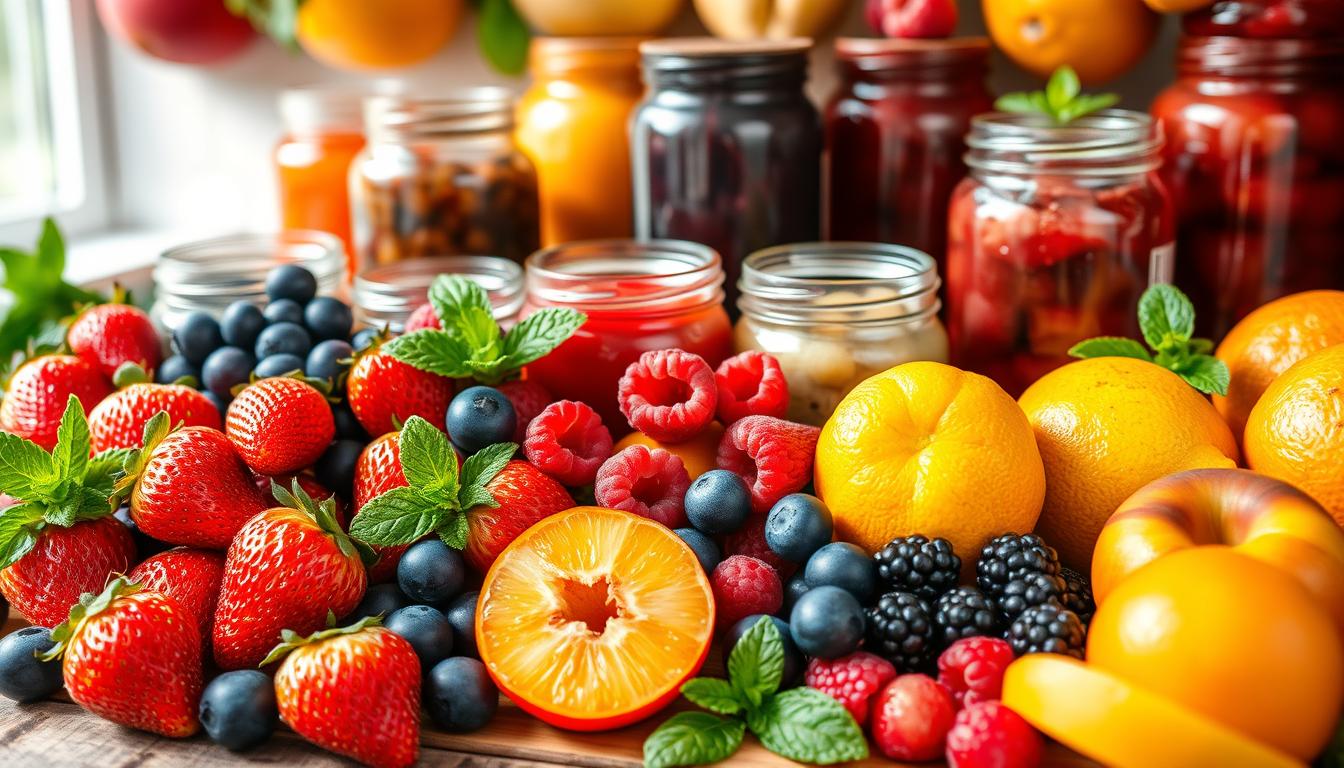Making homemade jams and preserves is a fun hobby and a great way to use your homegrown fruits. Choosing the right fruits for homemade jams and preserves is key. I pick fruits that are in season and have lots of pectin for the best taste and texture.
This guide is to inspire others to explore their fruit gardens. It’s about turning fresh fruits into tasty homemade preserves. From strawberry jams to wild blueberry preserves, there’s a lot to discover.
Key Takeaways
- Optimize fruit selection based on in-season availability for the best flavor.
- Integrate fruits high in pectin for efficient gelling in jam recipes.
- Utilize proper storage practices to extend the shelf life of homemade jams.
- Differentiating components of jams, jellies, preserves, and marmalades enrich my preservation skills.
- Follow guidelines for water bath canning to ensure safe and sealed jars.
Introduction to Homemade Jams and Preserves
Making homemade jams and fruit preserves lets me enjoy seasonal fruits all year. It’s a fun way to get creative in the kitchen, trying out different flavors and sweetness levels. Using fruits from my garden makes it even more special.
Doing this craft makes every day a little more special. I find new fruit garden ideas that help my garden grow. It also lets me pick healthy ingredients, making each jar just right for me.
Learning to preserve fruits is both an art and a science. I get to decide how sweet or tart each batch will be. It’s a journey that makes me love seasonal fruits even more.
Benefits of Making Your Own Jam
Making my own jam is a game-changer for my cooking and health. I get to pick healthier ingredients for my homemade preserves. This means I avoid artificial additives and too much sugar by using fresh, organic fruits. It makes my jam a healthier choice that fits my diet better.
Healthier Ingredients
Choosing my ingredients means I use only the best fruit for jamming. Fresh produce not only tastes better but also keeps more nutrients. This focus on quality makes my jams not just tasty but also good for you. Fruits like apples and citrus peel help thicken my jams, so I don’t need to add as much.
Control Over Sweetness and Flavor
When I make my own jams, I have full control over how sweet and what flavors they have. I can adjust the sweetness to my liking, making each batch special. I love trying out new spices, herbs, or fruit combinations. Whether it’s a sweet raspberry jam or a spiced peach preserve, I can make it just the way I want.
| Type of Fruit | Pectin Content | Best Use |
|---|---|---|
| Apples | High | Jam |
| Blueberries | Low | Best with high-pectin fruit |
| Citrus Peels | High | Jam and preserves |
| Strawberries | Low | With powdered pectin |
| Raspberries | Moderate | Freezer jam |
Best Fruits to Grow for Homemade Jams and Preserves
Choosing the right fruits is key for making tasty homemade jams and preserves. The best fruits not only add flavor but also make jam-making easier. Fruits high in pectin are especially good because they help achieve that perfect jelly-like texture.
Fruits High in Pectin
Apples, grapes, and berries are top choices for jam because they’re high in pectin. Here are some excellent options:
- Apples
- Oranges
- Raspberries
- Blackberries
- Blueberries
- Cherries
These fruits are perfect for jams and can even grow in small spaces, like container gardens. Dwarf fruit trees make it possible for anyone to grow fruit, no matter the garden size.
Seasonal Fruits for Optimal Flavor
Using seasonal fruits is crucial for the best flavor. Fresh, ripe fruits picked at their peak make my jams taste amazing. Here are some seasonal fruits to try:
- Strawberries in late spring
- Raspberries and blackberries in summer
- Peaches and plums in mid to late summer
- Apples and pears in the fall
These fruits not only taste great but are also often cheaper. This makes jam-making fun and budget-friendly. Picking fruits at their best ensures every jar of homemade preserves captures the season’s essence.
In-Season Fruits for Jam Making
Using seasonal fruits makes my jams taste better. It also means I’m using what’s available at the right time. Knowing which fruits are in season is key for jam-making fun. Spring and summer offer a variety of spring fruits and summer fruits perfect for making tasty spreads.
Spring and Summer Fruits
In spring, strawberries, cherries, and blueberries are at their best. These jam-making fruits add bright flavors and colors to my preserve recipes. The abundance of strawberries and blueberries lets me try new combinations, like mixing up to four fruits for a delicious spread.

Fall Fruits to Consider
In fall, I focus on fall fruits like apples and pears. They offer a sweet flavor that’s great in jams and preserves. I love exploring different apples for my jam, each adding a special taste. This helps me improve my preserve recipes for the holidays.
To learn more about growing these fruits, visit GardenBeginner.com. Growing the best fruits for jam-making adds to the fun of gardening.
Ripeness: Key to the Perfect Jam
Finding the right time to pick fruit is crucial for making the perfect jam. Ripe fruits have more natural sugar, which makes them sweeter and helps the jam gel. Overripe fruits are great for jam because they’re sweeter and need less added sugar.
But, underripe fruits are not as good. They have lots of pectin but lack flavor. The best mix is three-fourths ripe fruit and one-fourth underripe. This balance is key for a jam that’s both tasty and has the right texture.
Knowing which fruits have more pectin helps too. Fruits like blackcurrants and quinces are great for their gel-like texture. But fruits like strawberries need more sugar and acid to get right.
Trying new flavor mixes is also important. Using the right cooking temperature, around 220°F, helps make a jam that’s rich and full of flavor. This way, my jams are not just good but also follow the Jam & Related Products rules.
Using fruits at their best, whether frozen or fresh, makes my jams special. They meet my high standards and could even win in a jam contest.
Choosing Quality Fruits for Jam
Choosing the right fruits is key to making delicious homemade preserves. High-quality fruits make the jam taste better and feel nicer. I pick firm, juicy fruits without bruises or blemishes. The quality of the fruit is crucial for the jam’s flavor.
Characteristics of High-Quality Fruit
When picking fruit for jam, I look for certain traits. Look for:
- Firmness: Fruits should feel solid to the touch, indicating optimal ripeness.
- Juiciness: A juicy fruit contains more natural goodness and flavor.
- No Blemishes: Avoid fruits with bruises or unappealing spots as they can compromise the flavor.
- Ripeness: A balance of ripe and slightly under-ripe fruit is ideal for pectin content, perfect for making jam.
Fruits like apples, mangoes, or citrus add natural pectin. These qualities make my homemade preserves taste great and feel right.
Fruit from Local Markets vs. Grocery Stores
Fruits from local markets are often fresher than those from grocery stores. Local markets offer fruit picked from nearby farms. This makes the jam taste better.
- Riper: These fruits are often selected at their peak ripeness, crucial for jam production.
- Varied: Local vendors frequently supply unique or heirloom varieties not commonly found in grocery stores.
- Flavorful: The flavor of fresh, local produce enhances the overall quality of my homemade preserves.
Using these high-quality ingredients makes every batch of jam special. For more info, check this disclaimer.
Top Fruits for Jam Making
Choosing the right fruits is key to making amazing homemade preserves. Knowing which fruits work best can make your jam truly special. Let’s explore two top fruits for making delicious jams.
Blueberries: Ideal for Jamming
Blueberries are a top choice for jam because they’re sweet and have lots of pectin. Pectin helps your jam set just right. When picking blueberries, look for their deep blue color and a bit of softness when pressed.
These berries not only add color but also a tangy sweetness. Their flavor is perfect for summer spreads.
Peaches and Apricots: A Summer Delight
Peaches and apricots are summer’s stars, known for their juicy sweetness and scent. They have just the right amount of pectin for jam. But, you might need to tweak the recipe for the perfect texture.
Mixing peaches and apricots creates a refreshing summer jam. The peach’s tropical taste and the apricot’s tartness are a great combo. It’s perfect for topping toast, pastries, or even yogurt.
If you’re into making jams, knowing how to balance sugar and fruit is important. A 1:1 sugar-to-fruit ratio is a good starting point. But feel free to adjust it to your liking.
Also, check out this privacy policy for tips on handling fruit safely. It helps you make great jam while keeping things private.
Fruit Cultivation Tips for Jam Making
Making delicious homemade jam starts with growing the right fruits. Choosing the right varieties boosts flavor and ensures a good harvest. It’s important to consider your local climate and soil when picking fruits for jam. This way, you get the best fruit for your preserves.
Choosing the Right Varieties
To grow the best fruits, pick varieties that do well in your area. Here are some tips to help you:
- High Pectin Fruits: Apples (especially Bramleys), blackcurrants, gooseberries, damsons, and sour plums are great. They have lots of pectin, which helps set the jam.
- Medium Pectin Fruits: Raspberries, early blackberries, and ripe plums are good choices. They have a good balance of sugar and flavor.
- Low Pectin Fruits: Strawberries, late blackberries, pears, peaches, cherries, and rhubarb are tasty but need more sugar.
- Monitor Sugar Ratios: For high pectin fruits, use 640-750g of sugar per 500g of fruit. Medium pectin fruits need equal amounts of fruit and sugar. Low pectin fruits need about 380g of sugar for every 500g of fruit.
Remember, cooking time is key. Soft fruits take about 15 minutes to jam up. Harder or dried fruits might take up to 45 minutes.
Also, try using honey or maple syrup instead of sugar. They add unique flavors to your jam without losing quality.

| Fruit Type | Pectin Content | Sugar Ratio |
|---|---|---|
| Apples (Bramleys) | High | 640-750g sugar per 500g fruit |
| Raspberries | Medium | Equal parts fruit and sugar |
| Strawberries | Low | 380g sugar per 500g fruit |
| Blackcurrants | High | 640-750g sugar per 500g fruit |
| Peaches | Low | 380g sugar per 500g fruit |
With these tips, you can grow the best fruits for your jam. This will make your homemade jam even more delicious.
Homemade Preserves: More than Just Jam
Starting to make homemade preserves opens up a world of flavors beyond just jam. It’s key to understand the differences between jams and jellies to see the art in fruit preservation. Each type offers unique textures and tastes, making my cooking more exciting.
Differences Between Jams, Jellies, and Preserves
Knowing the differences between these spreads can make cooking better. Here’s a quick summary:
| Type | Description | Texture |
|---|---|---|
| Jam | Made from crushed fruit, resulting in a thick consistency. | Soft and spreadable |
| Jelly | Created from fruit juice, leading to a clear and smooth spread. | Jelly-like and firm |
| Preserves | Features larger fruit pieces suspended in syrup. | Chunky and fruity |
Using these homemade preserves in my cooking opens up endless possibilities. Each type can add something special to various dishes, from sweet to savory. Making my own jams and jellies lets me create marinades, sauces, or vinaigrettes that enhance the flavors of meats and salads. It’s amazing to think about how different jams can bring new tastes to my cooking.
Fruit Preservation Techniques
Preserving fruit lets me enjoy my homemade jams all year. There are many fruit preservation techniques to keep flavors bright and fresh. One favorite is canning fruit, using a simple syrup of equal parts water and sugar. I often can fruits like strawberries, blueberries, and fresh peaches. When canning, I leave about 3/4 inch of space at the top of the jar.
Choosing the right fruits for jam-making methods is key. I sort fruits into three groups based on their natural pectin and acid levels. This helps in making the perfect jam.
| Group | Fruits | Requirements |
|---|---|---|
| 1 | Apples, Sour Cherries, Cranberries, Currants, Gooseberries | Natural pectin and acid sufficient for gel formation with added sugar |
| 2 | Ripe Apples, Grapes, Loquats, Oranges, Apricots, Raspberries | May require additional acid or pectin for proper gel formation |
| 3 | Ripe Blackberries, Chokecherries, Grapefruits, Peaches, Pears, Plums, Strawberries, Figs | Always needs added acid, pectin, or both for optimal gel consistency |
Using pectins as directed is crucial. Swapping types can change the jam’s quality. For those looking for less sugar, modified pectins are a good choice. Freezing is another great way to preserve fruits. I make sure they are dry and add 3 tablespoons of lemon juice for each quart to keep them fresh. Freezer jam is easy since it doesn’t need sealed lids and can be stored in half-pint Mason jars.
Storing and Enjoying Your Jams
Keeping homemade preserves fresh is key. Knowing how to store them right lets me enjoy them at their best. I use small glass mason jars for this. They keep my jams fresh for 2 to 3 weeks in the fridge and up to 3 months in the freezer.
Best Storage Practices
Here are some tips for storing jam:
- Make sure jars are clean before filling to prevent contamination.
- Place filled jars upside down for a few minutes to seal them.
- Write the date on the jar so you know how long it’s been there.
Strawberries, a favorite jam fruit, are on the EWG Dirty Dozen List. This means they have high pesticide levels. So, it’s crucial to choose strawberries wisely for my jam recipes.
Creative Uses for Homemade Jams
Homemade jams are more than just for toast. They can make many dishes taste better. Here are some ideas:
- Put them on ice cream or yogurt for a tasty treat.
- Add them to pancake or waffle batter for extra flavor.
- Use them in marinades for meat or dressings for salads.
- Make them a filling for pastries or cakes.
Homemade jams offer endless possibilities in the kitchen. Whether I’m trying new preserves recipes or looking to spice up my meals, each jar adds a burst of flavor. It makes every dish a joy to eat.
Conclusion
Reflecting on making homemade jams and preserves, I find joy and satisfaction. Using the best fruits for jam-making is an art. It’s not just tasty but also a chance to grow my own fruits.
Every moment spent growing my fruits, like strawberries or peaches, makes the jam better. Understanding pectin and trying different fruit mixes creates unique flavors. Adding herbs and spices like rosemary or cinnamon makes each batch special.
Knowing how to mix sugar and fruit, and how to store them, keeps my jams fresh for months. If you want to try jam-making, go for it. It’s rewarding and fun. For more on jam science, check out this article. Start your cooking adventure and enjoy the sweet results!



Leave a Reply